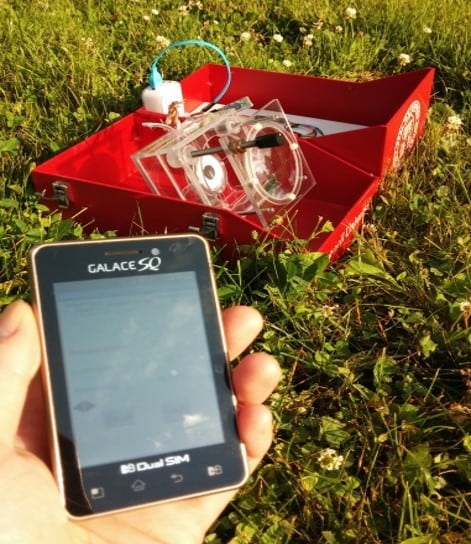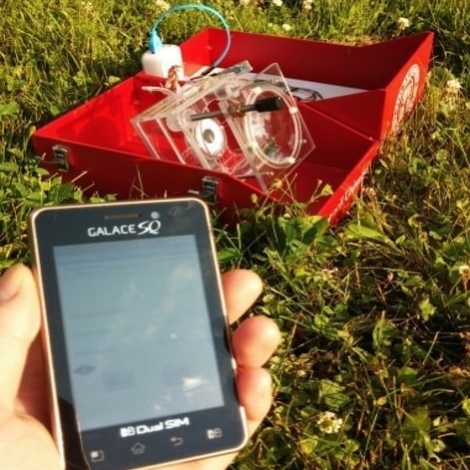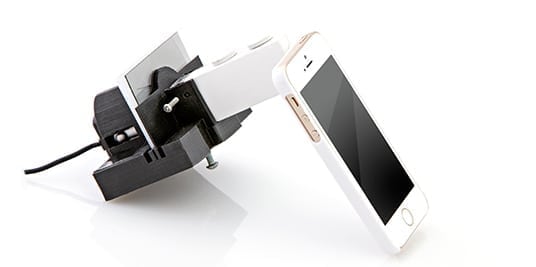
This could be the short-term future of India’s energy sector. No picture is available for the Intel team’s generator. Photo by Mark van Luyk / All Ears Cambodia
You won’t find many polymerase chain reaction thermocyclers in rural Kenya, but you will find a lot of people who could use one. The PCR is a mainstay of disease detection, but it has been frustratingly scarce in the world’s hard-to-reach communities. The reason, in part, is because the equipment can be expensive, bulky to lug around and a power guzzler in a region where reliable outlets are rare.
Fortunately, smart phones might change that. David Erickson and his team from the Sibley School of Mechanical and Aerospace Engineering at Cornell University in Ithaca, New York, have built a solar-powered PCR thermocycler that pushes the sample analysis onto a phone with an add-on and an app. The team tested their equipment outside of Eldoret in western Kenya in 2014 and presented findings from their research in April at the American Society of Mechanical Engineer’s Global Conference on Nanoengineering for Medicine and Biology in Minneapolis.
In Kenya, the rate of Kaposi’s Sarcoma is among the highest in the world. The cancer afflicts people with compromised immune systems, including AIDS patients. A biopsy test requires a PCR thermocycler set to detect the herpesvirus that causes the disease. PCR will find and copy the virus’ DNA enough times to register on a color-change test.
How does PCR work?
PCR starts with two primers, which are two single strands of unzipped DNA that match the thing it is looking for. In Kenya, the primers were from cancer DNA. The process requires three phases, each in a different temperature.
The first step is denaturation, in which the DNA double helix unzips into two single strands at a temperature of 94° C (201.2°F).
Next, the sample has to cool to 54°C (129.2F) for the annealing phase, in which the primers glom onto the single strand of DNA that they are set to detect. In this case it’s the kaposi’s Sarcoma-associate herpesvirus. The primer plus the single strands make whole, double stranded DNA sequences, and the polymerase enzyme goes to work copying them. In the third phase, the sample is heated to 72°C (161.6°F) for the extension, in which the polymerase works most efficiently. The enzyme runs along the strand pulling in raw material to copy it. Then the machine repeats the three steps dozens of times. This animation shows the concept.
The mechanics of copying the DNA, the amplification process, are not technically difficult. As Kary Mullis, the creator of the technique, wrote in The Scientific American in 1990, “Beginning with a single molecule of the genetic material DNA, the PCR can generate 100 billion similar molecules in an afternoon. The reaction is easy to execute. It requires no more than a test tube, a few simple reagents, and a source of heat.”
How can it work off the grid?
Traditional thermocyclers heat and cool the samples with electricity. Erickson and his team fit their off-grid version with a lens that concentrates the sun onto the sample. They point the lens at the sun and it heats the chambers in the sample to the right temperatures. The sample itself is in a chip carved with channels through which the sample moves. The chambers are temperature regulated by masks that allow only certain amounts of solar heat to enter.
When the sample has cycled and the DNA is copied, the user places the sample in a mobile-phone accessory. The accessory clips over the phone’s camera and acts like a pregnancy test, changing color in the presence of DNA from Kaposi’s Sarcoma. The phone reads the results through its camera and analyzes it using an app developed for this system.
“The game is how to do something useful without using any infrastructure,” Erickson told E4C. The sun does the heavy lifting, so for a 30-minute cycling session the machine consumes only 80mW. An iPhone battery can power it for 70 hours, Erickson and his colleagues wrote in a paper published in February 2014 in Nature. Their field system includes a small photovoltaic panel for the hardware.
“We tried to build an advanced diagnostics system around a cell phone,” Erickson says. “We got it operating off of a 4000 shilling phone [US$40] I bought off the street in Eldoret.”
The advantages are lower cost and higher portability. And there should not be a sharp learning curve for a program based on mobile phones, Erickson says.
Other experts like the idea.
“I think that, due to their ubiquity, smartphones make an excellent platform for third world health solutions to which lab-on-chip based devices can be added. Also, the incorporation of power considerations into designing analytical instruments for resource-limited settings is very important. Utilizing solar power to supply the energy and thermal gradients needed for PCR is a very nice example for such system level design,” says Holger Schmidt, a professor of electrical engineering at the University of California at Santa Cruz, and Director of the Optical Society of America, who is not involved in developing the technology.
Is it accurate?
Readings from the cellphone add-on compared to those from a standard spectrometer, Dr. Erickson said in his presentation at the nanoengineering conference. Early data find that the test may have a sensitivity rate, or true positive rate, of more than 90 percent. And it may have a false positive rate of about 5 percent.
Is it versatile?
“It is a PCR machine so it’s good for amplifying nucleic acids in any application,” Erickson says. For now the researchers are developing the Kaposi’s sarcoma test, but a PCR-based test could detect many other kinds of cancers, HIV, tuberculosis and other bacteria and viruses.
Erickson’s cellphone-based system may be a first, but others are working on low-cost PCR that may also have a place in clinics and field testing in rural communities. The OpenQPCR for “biohacking” is in the works after meeting its funding goal in a Kickstarter campaign in December, 2014.
And OpenPCR’s open source thermocycler is available as a kit for self assembly or as a construction guide. We saw an early version of it at a Better World by Design in 2010.
Further reading
Detection of Kaposi’s sarcoma associated herpesvirus nucleic acids using a smartphone accessory
Solar thermal polymerase chain reaction for smart-phone based diagnostics

